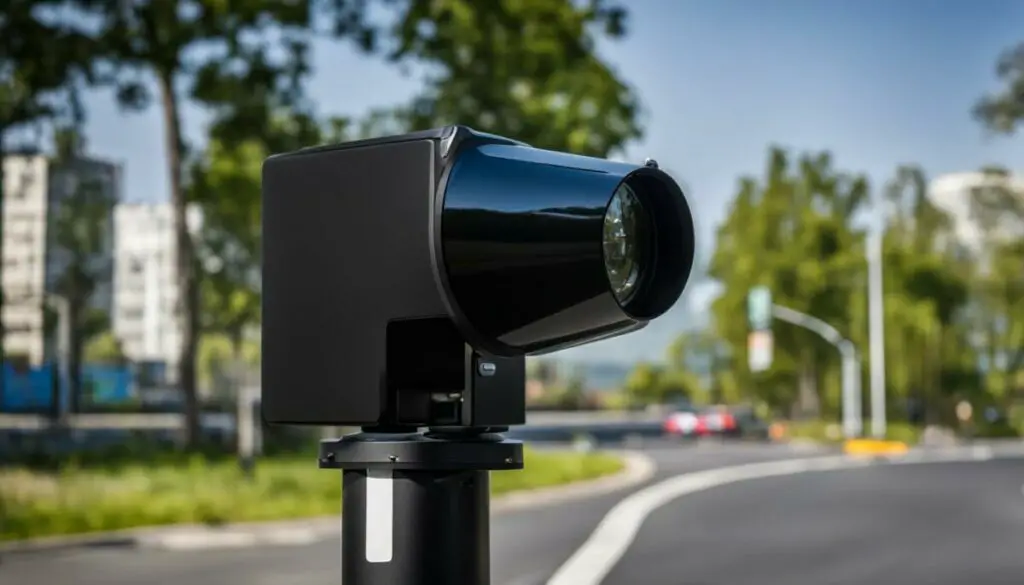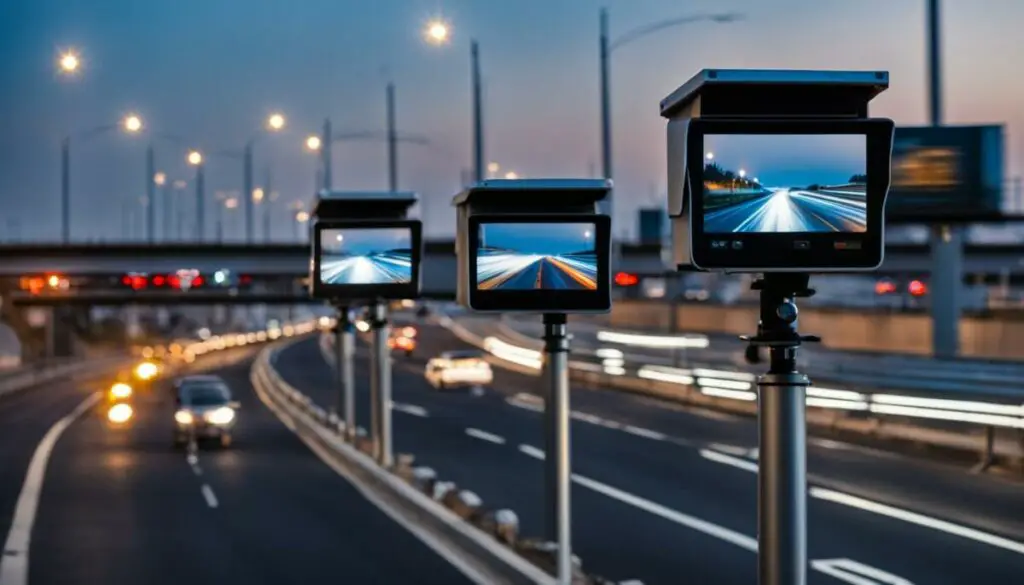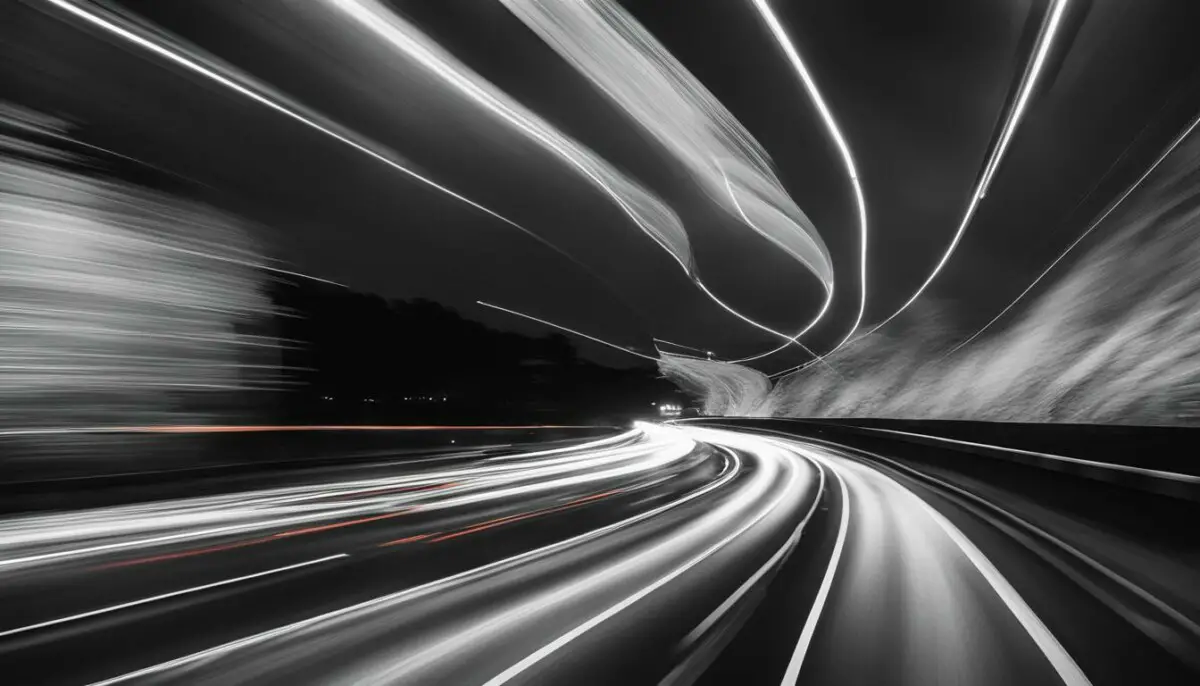Last Updated on 4 months by Francis
Speed cameras are a vital component of automated traffic enforcement, aimed at identifying and addressing speeding violations. While they share similarities with red light cameras, which capture red light violators, speed cameras specifically target drivers exceeding the speed limit. Some speed cameras employ infrared technology, enabling them to function effectively during both day and night, with improved sensitivity under low-light conditions. In this article, we will delve into the use of infrared technology in speed cameras and how it enhances traffic safety and the efficiency of enforcement.
Contents
Key Takeaways:
- Speed cameras are automated traffic enforcement cameras that detect speeding violations.
- Some speed cameras utilize infrared technology to improve low-light sensitivity.
- Infrared technology enhances the accuracy and effectiveness of speed camera systems, allowing for reliable detection and identification of speeding violations.
- Speed cameras with infrared technology contribute to traffic safety by promoting compliance with speed limits and reducing accidents caused by speeding.
- Varieties of traffic monitoring cameras include red light cameras, traffic sensor cameras, and automated number plate recognition (ANPR) cameras.
Understanding Different Camera Types for Traffic Monitoring

When it comes to traffic monitoring, various types of cameras play a crucial role in ensuring road safety and efficient traffic management. Let’s take a closer look at three key camera types used in this field: traffic cameras, red light cameras, and speed cameras.
Traffic Cameras
Traffic cameras are primarily used to monitor traffic flow and aid in determining the timing of traffic lights. These cameras are strategically positioned at key locations, such as highway interchanges and major intersections. By capturing real-time footage, traffic cameras provide valuable insights into congestion patterns, allowing traffic engineers to optimize signal timings and promote smoother traffic flow.
Red Light Cameras
Red light cameras serve as automated ticket-issuing systems installed at intersections. Their purpose is to detect and penalize drivers who enter the intersection when the traffic signal is displaying a red light. The cameras capture multiple images of the violating vehicle, allowing authorities to issue traffic citations to the vehicle’s owner. This serves as an effective deterrent against reckless driving and helps reduce the risk of intersection accidents caused by red light violations.
Speed Cameras
Speed cameras, on the other hand, are designed to automatically detect and issue violations for speeding violations. With a focus on curbing excessive speed, these cameras are often placed in areas with a history of speeding complaints or near schools and residential zones. Speed cameras can be either fixed, mounted on elevated poles, or mobile, installed on tripods or inside vehicles. By capturing images or video footage, speed cameras provide irrefutable evidence of speeding violations, promoting safer driving habits and reducing the risk of accidents on the road.
Understanding the different types of cameras used in traffic monitoring helps us grasp their respective functions and contributions to road safety. Let’s explore additional aspects of automated enforcement cameras in the following sections.
Automatic Enforcement Cameras: Red Light Cameras

Red light cameras are automated ticket-issuing systems placed at busy intersections to detect drivers who run red lights. These cameras capture multiple images of the violating vehicle and subsequently issue a ticket to the vehicle’s owner. Red light cameras are distinguishable by their location near intersections and their bulkier appearance compared to other camera systems. It is important to note that red light camera tickets are classified as administrative violations, similar to parking tickets, and do not allow the accused driver to face their accuser in court.
| Advantages of Red Light Cameras | Disadvantages of Red Light Cameras |
|---|---|
| 1. Improved intersection safety by deterring red light runners. | 1. Limited effectiveness in reducing severe accidents at intersections. |
| 2. Automated enforcement ensures consistent ticketing for red light violations. | 2. Challenges with accurate identification of drivers due to obscured license plates or shared vehicle use. |
| 3. Reduces potential conflicts and increases compliance with traffic signals. | 3. Perception of revenue generation instead of prioritizing safety. |
“Red Light cameras have been proven to be an effective tool in reducing the number of accidents caused by red light running. However, there are concerns regarding their impact on intersection safety and privacy.” – Traffic Safety Expert
Red light cameras serve as a deterrent to drivers who may be tempted to run a red light. Their automated enforcement ensures consistent ticketing for such violations, contributing to safer intersections and improved traffic flow. However, there are concerns about the accuracy of red light camera systems in identifying drivers, especially when license plates are obscured or multiple individuals have access to the vehicle.
Despite these challenges, red light cameras have proven to be an effective tool in reducing accidents caused by red light running. By highlighting the importance of intersection safety and encouraging drivers to comply with traffic signals, these cameras play a vital role in promoting safer road behavior.
Automatic Enforcement Cameras: Speed Cameras

Speed cameras play a crucial role in enforcing speed limits and promoting safer driving. These cameras are strategically placed in areas where speeding is a common issue, such as back roads or residential areas. Equipped with automatic detection technology, speed cameras can identify vehicles that exceed the speed limit and issue violations accordingly. They come in two main types: fixed and mobile.
Fixed speed cameras:
Fixed speed cameras are typically mounted on elevated poles along roads and highways. They are stationary and capture the speed of passing vehicles using advanced sensors. By accurately measuring the speed, these cameras can identify and document instances of speeding violations. The data collected is then used for enforcement purposes, ensuring that drivers are held accountable for their actions.
Mobile speed cameras:
Mobile speed cameras offer flexibility in monitoring speeding violations. They can be installed on tripods or placed inside vehicles, allowing for easy deployment in various locations. Mobile speed cameras often utilize low-powered K-band and MRCD radar to detect speeding vehicles. These radar systems are designed to be difficult for standard radar detectors to detect, increasing the effectiveness of speed camera enforcement.
It’s important to note that speed cameras cannot be “beat” or tricked by conventional methods. However, drivers can reduce their chances of detection by slowing down when approaching known or suspected camera locations.
By utilizing automatic detection technology, speed cameras contribute to enhancing road safety and reducing speeding violations. They serve as a constant reminder for drivers to adhere to speed limits, ultimately creating a safer environment for both drivers and pedestrians.
Non-Enforcement Cameras: Traffic Sensor Cameras

Traffic sensor cameras play a vital role in monitoring and managing traffic conditions. As the most common type of camera used for traffic monitoring, they can be found on top of traffic signals or mounted on light poles. These cameras are primarily utilized for measuring traffic flow and determining traffic light timing, contributing to improved traffic management and efficiency.
Unlike enforcement cameras, traffic sensor cameras are not connected to ticket-issuing systems, and their videos are not typically used for incident reconstruction. Instead, their main function is to provide real-time data on traffic volumes, speeds, and congestion levels.
By capturing traffic movements and analyzing the data collected, traffic sensor cameras enable authorities to make informed decisions to optimize traffic signal timing, reduce traffic congestion, and enhance overall traffic flow. They serve as invaluable tools in traffic management, helping create smoother and more efficient travel experiences for drivers and pedestrians.
Advantages of Traffic Sensor Cameras:
“Traffic sensor cameras provide real-time data on traffic flow, enabling authorities to optimize traffic signal timing and reduce congestion.”
Here are some key advantages of using traffic sensor cameras for traffic flow monitoring:
- Accurate Traffic Volume Measurement: Traffic sensor cameras use advanced technologies to accurately count the number of vehicles passing through an intersection or a roadway segment. This data helps traffic engineers and planners understand traffic patterns and make informed decisions.
- Efficient Traffic Signal Optimization: By analyzing traffic data collected from sensor cameras, authorities can adjust the timing of traffic signals to better accommodate traffic flow and reduce delays. This optimization leads to improved traffic efficiency and reduced travel times.
- Real-Time Congestion Monitoring: Traffic sensor cameras provide real-time information about traffic congestion levels. This data allows authorities to identify congested areas and take immediate actions, such as adjusting traffic signal timings or implementing alternative routes, to minimize congestion and its impact on traffic flow.
- Data-Driven Decision Making: The data captured by traffic sensor cameras serves as a valuable resource for traffic engineers and planners. It helps them make data-driven decisions when developing transportation plans, improving infrastructure, and implementing targeted traffic management strategies.
By leveraging the advantages of traffic sensor cameras, authorities can gain valuable insights into traffic patterns, optimize traffic signal timings, and proactively manage traffic flow. These cameras contribute to safer and more efficient roadways, enhancing the overall driving experience for everyone on the road.
Non-Enforcement Cameras: Automated Number Plate Recognition (ANPR) Cameras

ANPR cameras, equipped with artificial intelligence, possess the ability to read and recognize license plate numbers. These highly advanced cameras can be found in both mobile and fixed forms, mounted on police vehicles or poles. The primary function of ANPR cameras is to track the whereabouts of drivers, automatically scanning and cross-referencing license plates with government databases. Their applications extend beyond mere tracking, serving various purposes such as identifying vehicles with outstanding warrants or expired insurance. Operating in the invisible infrared light spectrum, ANPR cameras are often equipped with clusters of infrared LEDs to enhance their low-light sensitivity. These state-of-the-art cameras play a vital role in modern surveillance and law enforcement efforts.
“ANPR cameras utilize cutting-edge technology to track and monitor drivers’ activities, providing law enforcement agencies with valuable insights and ensuring greater accountability on the roads.”
Advantages of Infrared Technology in Speed Cameras

Infrared technology plays a crucial role in enhancing the accuracy, visibility, and effectiveness of speed cameras. The use of infrared light in speed cameras offers significant advantages in various lighting conditions, ensuring reliable detection and capture of speeding violations.
Improved Low-Light Sensitivity
Infrared technology provides better low-light sensitivity, enabling speed cameras to operate effectively during nighttime or in low-light situations. By utilizing infrared light, speed cameras can capture clear images even in challenging lighting conditions, ensuring accurate detection of speeding violations.
Enhanced Accuracy in Challenging Lighting Conditions
The use of infrared light in speed cameras enhances their accuracy by reliably differentiating between vehicles and other objects in challenging lighting conditions. Unlike traditional cameras, which may struggle to capture clear images in low-light or high-glare situations, infrared technology ensures that speed cameras accurately identify and capture speeding violations.
Clear Image Capture and Accurate Identification
Infrared technology improves visibility, allowing speed cameras to capture high-quality images for accurate identification of speeding violations. With enhanced visibility, speed cameras equipped with infrared technology can provide clear evidence of speeding incidents, making it easier for authorities to identify and take appropriate enforcement actions.
By integrating infrared technology into speed cameras, traffic enforcement agencies can enhance the accuracy and effectiveness of speed monitoring, contributing to improved road safety and reduced accidents caused by speeding.
Benefits of Speed Cameras and Infrared Technology
The use of speed cameras with infrared technology offers numerous benefits for traffic safety. By enforcing speed limits and promoting safer driving behavior, speed cameras effectively deter drivers from speeding. The integration of infrared technology enhances the accuracy and effectiveness of speed camera systems in detecting and capturing speeding violations, ultimately leading to better enforcement efficiency.
One of the key advantages of infrared technology in speed cameras is its ability to operate effectively in low-light conditions, including nighttime. The use of infrared light provides better low-light sensitivity, ensuring that speed cameras can accurately monitor and enforce speed limits at all times. This means that even in challenging lighting conditions, such as poorly lit areas or during bad weather, speed cameras equipped with infrared technology can reliably detect and capture speeding violations.
In addition, infrared technology improves the visibility of speed camera images. By enhancing the clarity and detail of captured images, speed cameras equipped with infrared technology can accurately identify vehicles and ensure that the right violators are held accountable. The enhanced visibility of speed camera images also reduces the likelihood of false accusations or misidentifications, further enhancing the reliability and effectiveness of speed camera systems.
Furthermore, the implementation of speed cameras with infrared technology enables authorities to better monitor and manage traffic flow. By accurately detecting and capturing speeding violations, speed cameras contribute to improved road safety by encouraging drivers to adhere to speed limits. This not only reduces the risk of accidents caused by speeding but also helps to minimize congestion and maintain smooth traffic flow.
Overall, the combination of speed cameras and infrared technology plays a vital role in enhancing traffic safety. Through their ability to deter speeding, improve enforcement efficiency, and promote better traffic management, speed cameras equipped with infrared technology contribute to a safer and more efficient transportation system.
“The use of speed cameras with infrared technology significantly enhances traffic safety by deterring speeding and improving enforcement efficiency.” – Traffic Safety Authority
The Role of Multi-Sensor Approach in Traffic Monitoring
A multi-sensor approach utilizing both visible spectrum cameras and thermal cameras can provide comprehensive traffic monitoring capabilities. By combining the strengths of these technologies, traffic management authorities can enhance their ability to monitor and respond to traffic conditions effectively.
Visible Spectrum Cameras
Visible spectrum cameras play a crucial role in detailed monitoring and verification of vehicles. These cameras capture images in the visible light spectrum, allowing for clear identification of license plates, vehicle colors, and other visual details. The information captured by visible spectrum cameras is valuable for traffic flow analysis, incident investigation, and evidence collection.
Thermal Cameras
Thermal cameras offer a unique advantage in traffic monitoring by detecting temperature differences. These cameras operate in the infrared spectrum, making them ideal for capturing critical information regardless of environmental conditions such as darkness, fog, or smoke. By detecting heat signatures emitted by vehicles, thermal cameras can reliably identify the presence of vehicles, pedestrians, or other objects in a given area.
Thermal cameras provide reliable detection results and have the added benefit of reducing false alarms. This is particularly useful in environments where traditional sensors may be triggered by factors such as moving vegetation or small animals. The ability of thermal cameras to distinguish temperature variations enhances their effectiveness in automatic incident detection systems.
Furthermore, thermal cameras can aid in the rapid response to incidents, such as vehicle fires or accidents, by detecting abnormal heat patterns. This early detection enables authorities to take immediate action, minimizing the impact of serious traffic incidents and facilitating timely incident management.
A Comprehensive Approach
By combining the strengths of visible spectrum cameras and thermal cameras, a multi-sensor approach to traffic monitoring offers a comprehensive solution for traffic management. The visible spectrum cameras provide detailed visual information for accurate identification and verification, while the thermal cameras enhance awareness and critical information regardless of challenging environmental conditions.
This multi-sensor approach enables traffic management authorities to analyze traffic flow, detect incidents, and respond in real-time, improving overall traffic safety and congestion management. It also allows for the integration of intelligent algorithms and machine learning techniques to further enhance the capabilities of the system.
Through this holistic approach, a multi-sensor system proves to be an effective tool in promoting safe and efficient traffic management.
Conclusion
In conclusion, the integration of infrared technology in speed cameras has proven to be a game-changer in traffic monitoring and enforcing speed limits. The use of infrared technology enhances the accuracy and visibility of speed cameras, enabling them to detect and capture speeding violations more effectively. This advancement in technology plays a vital role in promoting traffic safety and enforcement efficiency.
By adopting a multi-sensor approach that combines visible spectrum and thermal cameras, authorities can achieve comprehensive and effective traffic monitoring. The combination of these technologies enables timely detection and response to traffic incidents, ensuring the safety of road users. With the integration of infrared technology, speed cameras can provide clearer imaging and accurate identification of speeding violations, leading to enhanced traffic management and safer road conditions.
Incorporating infrared technology into speed cameras is a significant step toward reducing the number of accidents caused by speeding. These cameras act as powerful deterrents, encouraging drivers to adhere to speed limits and engage in responsible driving behavior. By promoting a culture of compliance, speed cameras with infrared technology contribute to the overall improvement of traffic safety in our communities.
FAQ
Are speed cameras infrared?
Yes, some speed cameras utilize infrared technology for better low-light sensitivity and effective operation day and night.
What are the different camera types used for traffic monitoring?
There are various camera types used for traffic monitoring, including traffic cameras, red light cameras, and speed cameras.
What are red light cameras?
Red light cameras are automated ticket-issuing systems placed at intersections to detect and penalize drivers who run red lights.
How do speed cameras work?
Speed cameras automatically detect and issue violations for speeding. They are typically found in areas where residents have complained of frequent speeding, such as back roads or residential areas.
What are traffic sensor cameras used for?
Traffic sensor cameras are primarily used for measuring traffic flow and determining traffic light timing. They help monitor and manage traffic conditions.
What are ANPR cameras?
ANPR cameras are equipped with artificial intelligence to read and recognize license plate numbers. They track the whereabouts of drivers and can cross-reference license plates with government databases.
What are the advantages of infrared technology in speed cameras?
Infrared technology offers better low-light sensitivity, accuracy in detecting speeding violations, enhanced visibility, and clear image capture.
What are the benefits of speed cameras and infrared technology?
Speed cameras with infrared technology help deter drivers from speeding, promote safer driving behavior, and improve traffic safety and enforcement efficiency.
What is the role of a multi-sensor approach in traffic monitoring?
A multi-sensor approach, combining visible spectrum cameras and thermal cameras, provides comprehensive traffic monitoring capabilities, reliable detection results, and rapid incident response.
Is speed camera infrared technology effective for traffic monitoring?
Yes, speed cameras utilizing infrared technology are effective in monitoring and enforcing speed limits, enhancing traffic safety, and reducing accidents caused by speeding.
Source Links
- https://radenso.com/blogs/radar-university/what-s-the-difference-between-traffic-cameras-red-light-cameras-and-speed-cameras
- https://medium.com/@joeshepdcruz/traffic-camera-vs-speed-camera-and-redlight-camera-how-are-they-different-71ca59743470
- https://www.flir.com.au/discover/public-safety/why-use-thermal-cameras-for-traffic-monitoring/








